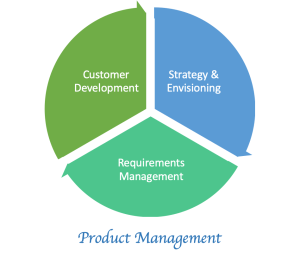About Product Management: A Practice Perspective
If you ever have googled about ‘product management’, you might have found hundreds of pretty interesting articles on how product management is an interdisciplinary organizational practice and how they help organizations realize their vision by building and launching a valuable product(s) for their customers. And, yes most describe product management as an intersection point between Business, UX and Technology (somewhat like the image below).
(Source: “What, exactly, is a Product Manager?” by Martin Eriksson)
This is true to an extent, that product management is all about having a good understanding of business, technology, and user experience and hence bringing about synergy in these three areas to build successful products. But it overtly simplifies the product management craft that is required for the success of both the Product Manager and the organization.
In my opinion, product management is much more than just a role. It is an organizational practice, a discipline in itself and not an interdisciplinary role. Sure, it needs a PM to work with multiple stakeholders from engineering, UX, sales, marketing, customer success, etc. But, hey is it not the case with most teams today. All organizations today operate in cross-functional zones to stay ahead of the game in their respective business. There is no room for siloed operations. The same is the case with product management.
Product management is an established practice in most of the successful product organizations. There are exceptions for sure in a few cases where product managers belong to the Engineering group to elicit and manage requirements or to marketing groups for brand management and customer development activities. And this depends upon whether the organization is engineering-driven or sales-driven. However, in most successful market-driven and customer-obsessed organizations, product management is a dedicated group of people. This is required because product management is not about just building new features/products but to build it right and make it successful by adding value to both your customers and business. It’s a practice of succeeding day after day, every day. It’s a practice about continued focus and continuous improvements.
Based on my study and analysis of various product teams in successful product organizations, its quite evident that product management practice broadly constitutes of 3 key pillars: Strategy & Envisioning, Requirements Management, and Customer Development.
Strategy & Envisioning: To build a successful product, it is imminent to have a well-defined product vision that is aligned with the business objectives. It is key to have a stable and long-term product vision. Vision is the foundation on which product strategy rests. A compelling product strategy chalks out the exact plan on how the product is going to go about and achieve market leadership. Typically it is both short term and long term and It demands product managers orient themselves towards business goals and set a direction for their product towards achieving that. Like any plan, the product strategy has to be re-visited periodically and re-iterated based on changing customer needs, competitive landscape, and market dynamics.
Requirements Management: For the product to be successful, it is key to encapsulate the exact set of product/feature requirements that should go into the product. This needs a systematic approach to identify product requirements by analyzing the market needs and deep-diving into customer problems with a solutions approach. Once the product requirements are identified, it has to be defined as software requirements for the software solution to be implemented and constantly prioritized and re-prioritized based on multiple factors such as business need, technological capabilities, complexity and availability of limited resources such as engineering capacity and time. The goal is not to spend too much time on just building the product but to get a minimum viable product out that can be taken to the customers and see its reception in the market.
Customer Development: This is all about how to take your product to the market, acquire customers and make a business out of it. As explained by Steve Blank in his book ‘The Four Steps to Epiphany’, customer development constitutes of four steps: customer discovery, customer validation, customer acquisition and scaling the product business. Customer discovery and validation aims to find the right product-market fit. It includes identifying the customer segment, a market for your product and then assesses problem-solution fit for the product that you have conceptualized. This is a process in itself that includes continuously defining hypothesis based on your opportunity analysis and then rapid experimentation with your minimum viable product (or product concept) until you find the right market. Once you have achieved the product-market fit, then you have to work all your energies out on various customer acquisition strategies and push for customer adoption and then scale your product and operations to leapfrog your product business.
Now, it is not that these key pillars are explicit in product organizations but broadly covers what product teams do. Many product companies have even dedicated roles like product strategists, product planners, product strategy managers who work on product strategy alone. Similarly, product marketing specialists and allied roles do exist in various companies which are meant for customer development and agile methodologies itself to describe a dedicated role of a ‘product owner’ to plan and manage requirements. Amidst all these various roles, as product management practice continues to evolve it would be interesting to see if there would be a 3 in a box (Product Strategist + Product Owner + Product Marketer) approach adoption by product organizations in near future.
Hope it makes sense. Happy building classy products & delighting your customers!
P.S: Learn more on the Product Management concepts, processes, and strategies from my free videos on Antwak.
More readings and references:
https://www.mindtheproduct.com/what-exactly-is-a-product-manager/
Cagan, Marty (2018). Inspired: How to create tech products customers love (2nd ed.). Wiley India
Blank, Steve (2005). The Four Steps to the Epiphany: Successful Strategies for Startups That Win (3rd ed.). K&S Ranch


